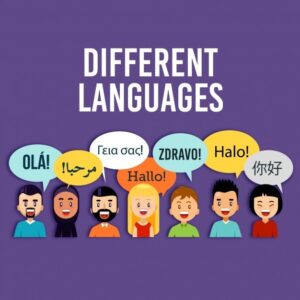Tonal languages present a distinct set of challenges that can pose significant difficulties for new learners. These languages depend heavily on pitch and tone to convey meaning, which often results in confusion surrounding similar sounds and tonal shifts in various contexts.
This article examines the reasons why mastering tonal languages can be particularly challenging, highlights some of the most prevalent tonal languages worldwide, and offers practical tips to assist learners in navigating this complex linguistic landscape. Additionally, it addresses common pitfalls to avoid and outlines the rewarding benefits of achieving proficiency in a tonal language.
Readers are encouraged to enhance their understanding and skills in this intriguing domain of language learning.
Why Are Tonal Languages Difficult to Learn?
.jpg_00.jpeg)
Tonal languages pose distinctive challenges for language learners due to their dependence on pitch variation, intonation, and phonetics to convey meaning, which can create substantial linguistic barriers for novice speakers and new speakers.
As tonal contrasts become essential to pronunciation, comprehending them necessitates not only phonological awareness but also proficient auditory discrimination skills. This mastery can be particularly daunting for second language learners, often resulting in increased cognitive load and language anxiety that may impede effective communication.
Furthermore, the unfamiliarity with tonal languages, such as Mandarin, Vietnamese, and Thai, can exacerbate the complexities of language acquisition, phonological features, and overall language proficiency.
1. Mastering Tone and Pitch
Mastering tone and pitch is essential for learners of tonal languages, as these elements fundamentally alter the meaning of words, making tonal perception and understanding linguistic tones critical factors in achieving language proficiency and overcoming language barriers.
In languages such as Mandarin, Thai, and Vietnamese, a single syllable can have entirely different meanings based on its tonal inflection. For example, recognizing subtle shifts in pitch can distinguish between a simple greeting and a completely unrelated concept.
To enhance pronunciation and auditory skills, learners may utilize specialized pronunciation guides that provide tailored exercises focused on tone recognition and pitch differentiation. Regular exposure to native speakers and consistent practice with tonal exercises can reinforce these skills, ensuring that learners establish a strong auditory foundation that is vital for effective communication in these languages.
2. Differentiating Between Similar Sounds
Differentiating between similar sounds presents a significant challenge for learners of tonal languages, primarily due to the reliance on subtle phonetic variations and dialectal differences that can lead to misunderstandings and communication challenges.
These challenges may be further exacerbated by the presence of regional dialects, which introduce additional nuances in pronunciation that complicate effective auditory discrimination. For individuals embarking on the journey of mastering a tonal language, developing strong listening skills is essential, as these skills directly influence their ability to convey and comprehend meaning accurately.
To facilitate this learning process, a variety of language resources are available, including engaging audio materials and innovative language applications that focus on phonetic training. These resources provide learners with interactive exercises designed to enhance their sensitivity to tonal distinctions.
3. Understanding Tone Changes in Context
Understanding tone changes in context is crucial for effective communication in tonal languages, as intonation and tonal variation can alter the meaning of phrases based on contextual cues and cultural nuances.
This complex relationship between contextual comprehension, grammar, and expressive tones underscores the necessity for learners to concentrate on real-life scenarios during their practice.
By engaging in conversations that reflect everyday situations, learners can better understand how subtle variations in tone can convey different emotions or intentions.
Incorporating context-driven activities into language practice not only promotes fluency but also facilitates a deeper understanding of the grammatical structures, syntax, and morphology intrinsic to tonal languages.
As learners become more proficient in recognizing these nuances, their capacity to interpret and respond appropriately improves, resulting in more meaningful interactions and enhanced overall communication.
4. Limited Resources for Learning
One of the significant challenges in learning tonal languages is the limited availability of effective language resources, such as language courses and tutors who specialize in tonal pronunciation.
This scarcity can lead to frustration and impede progress, particularly for learners who are striving to master the subtle nuances that tonal variations and linguistic diversity present.
To enhance their education, individuals engaged in these languages should adopt a variety of study habits that promote a deeper understanding of the tonal components.
Consistent practice, such as listening to native speakers, utilizing language exchange platforms, or dedicating time to online resources that offer interactive exercises, can be particularly advantageous.
Furthermore, it is essential for learners to seek constructive feedback from peers or more experienced speakers to reinforce their understanding and rectify mispronunciations. This approach allows them to develop a more intuitive grasp of tonal variations as they advance in their language studies.
What Are the Most Common Tonal Languages?
Several languages worldwide are categorized as tonal languages.
Notable examples of tonal languages include Mandarin Chinese, Thai, Vietnamese, and Yoruba.
Each of these languages belongs to distinct language families and demonstrates unique regional accents.
1. Mandarin Chinese
Mandarin Chinese is arguably the most recognized tonal language, characterized by four distinct tonal contrasts that are essential for accurate phonetic pronunciation. Each tone can completely alter the meaning of a word, making tonal awareness critical for effective communication.
Mastering these tonal nuances extends beyond mere repetition and practice environments; it necessitates immersive language experiences that enhance listening skills and reinforce proper articulation.
Learners can derive significant benefits from interactive strategies, such as engaging in conversations with native speakers and utilizing language applications that emphasize phonetic exercises. These approaches can assist in balancing cognitive load, thereby facilitating more effective retention and application of pronunciation rules.
By embracing the tonal nature of Mandarin, individuals can achieve more authentic interactions and develop a deeper cultural understanding.
2. Thai
.jpg_01.jpeg)
Thai is a prominent tonal language recognized for its complex pitch variations that significantly influence meaning, necessitating learners to attain a high level of proficiency in the language.
This intricate tonal system comprises five distinct tones: low, mid, high, rising, and falling, each of which can completely alter the meaning of a word. For example, a single syllable may convey various concepts depending on its tone, underscoring the importance for speakers to master these pitch variations to ensure clear communication. Additionally, stress patterns in Thai further enhance the expressiveness of the language.
For individuals seeking to strengthen their understanding of Thai, resources such as online courses, language exchange programs, and interactive applications can be highly beneficial. Engaging with native speakers and practicing listening skills will also significantly contribute to grasping the nuances of this fascinating language.
3. Vietnamese
Vietnamese is classified as a tonal language, encompassing six distinct tones that present challenges for new speakers in terms of auditory discrimination and pronunciation. These tones are essential not only for conveying meaning but also for comprehending the nuances of the language itself.
For learners embarking on this linguistic journey, an understanding of these tonal classifications is crucial, as subtle differences in pitch can result in entirely different interpretations of words.
To facilitate the mastery of these tones, a variety of language resources are available, including interactive applications, online courses, and targeted pronunciation guides.
These tools can significantly assist learners in refining their auditory recognition skills and enhancing their overall communication efficacy, ultimately reducing the likelihood of misunderstandings during conversations.
4. Yoruba
Yoruba, although not as widely recognized as Mandarin or Thai, is a significant tonal language characterized by regional accents that can vary considerably, making language immersion and understanding of socio-cultural context essential for the development of effective communication skills.
The tonal nature of Yoruba indicates that variations in pitch can entirely alter the meaning of words, making it crucial for learners to comprehend this aspect. This complexity is further complicated by the presence of various dialects, each possessing unique characteristics and subtle nuances.
Engaging in immersive environments—such as participating in language exchange programs or conversing with native speakers—can significantly enhance language proficiency. By immersing oneself in authentic conversations, learners not only refine their pronunciation but also gain a deeper understanding of cultural context, thereby markedly improving their overall communication skills.
What Are Some Tips for Learning Tonal Languages?
Effectively learning tonal languages necessitates the implementation of targeted strategies, which include dedicated practice opportunities and active engagement in developing listening skills through a variety of language resources. Such strategies play a crucial role in language acquisition and improving language proficiency.
1. Practice Listening and Mimicking
Practicing active listening and mimicking native speakers constitutes a highly effective strategy for developing phonological awareness and improving tonal pronunciation, which are essential for mastering phonological features and tonal perception.
This method enables learners to internalize the rhythm and intonation patterns of the language, which are often challenging to master through traditional study methods alone. By participating in this immersive experience, individuals can significantly enhance their overall fluency, comprehension, and overall language retention.
To further augment this practice, it is advisable to incorporate various techniques such as active listening and repetition, where learners concentrate intently on conversations.
Engaging with resources such as language tutors who specialize in conversational practice, alongside utilizing audio materials like podcasts and music, and other language applications, can greatly assist in refining listening skills and addressing communication challenges.
These resources not only provide authentic language exposure but also facilitate engaging and enjoyable learning experiences, enhancing both auditory discrimination and language engagement.
2. Use Visual Aids and Mnemonic Devices
The use of visual aids and mnemonic devices can significantly enhance vocabulary retention and assist learners in recalling tonal patterns, a critical component for phonological awareness and effective communication.
By incorporating techniques such as color coding and imagery into their study methods, learners can establish mental associations that facilitate the retention of challenging words. For example, associating specific colors with particular tones or meanings can aid in differentiating subtle nuances in pronunciation, which is crucial for recognizing tonal distinctions and tonal variation in languages like Mandarin, Vietnamese, and Thai.
Utilizing flashcards that combine visuals with auditory cues allows for a multi-sensory approach, thereby increasing engagement and reinforcing comprehension. This method of integrating illustrations alongside text not only supports the memorization process but also helps learners understand the emotional context behind various expressions, ultimately leading to a more comprehensive mastery of the language. Such techniques are vital for new speakers striving to develop communicative competence and fluency.
3. Study the Tones and Their Meanings
The study of tones and their meanings in tonal languages is crucial for establishing a solid foundation in phonetics and facilitating effective communication. A comprehensive understanding of tones not only enhances linguistic proficiency but also fosters deeper connections among speakers. This understanding involves grasping the acoustic properties and syntax of tones within different linguistic contexts.
It is advantageous for learners to participate in practical exercises, such as tone drills and interactive speaking sessions, which can significantly enhance their understanding of tonal nuances and improve their pragmatic competence in real-world practice.
Enrolling in structured language courses offers valuable guidance, helping individuals in systematically navigating the complexities associated with tonal variations and dialectal differences, which are integral to phonological and tonal variation understanding.
These courses typically include listening activities and real-life conversation practices that emphasize how tones convey different sentiments and clarifications, ultimately enriching the learner’s overall language experience and comprehension skills.
4. Immerse Yourself in the Language and Culture
.jpg_10.jpeg)
Immersing oneself in the language and culture is essential for mastering tonal languages, as it enables learners to directly experience expressive tones, cultural nuances, and the socio-cultural context in which the language is spoken.
This comprehensive engagement not only improves pronunciation and intonation but also presents learners with the intricate social and cultural contexts in which the language is utilized, facilitating a more profound cultural understanding and pragmatic competence.
By actively participating in dynamic language communities and sharing experiences with native speakers, individuals are more likely to grasp contextual cues that enhance their overall comprehension, fluency, and interactional competence.
Navigating real-life situations—such as ordering food or participating in celebrations—provides invaluable insights that textbooks alone cannot offer. Such interactions foster quick thinking, boost learners’ confidence, and enable them to communicate more effectively by leveraging their improved speech perception and contextual cues recognition.
What Are Some Common Mistakes When Learning Tonal Languages?
Common mistakes encountered when learning tonal languages frequently stem from the mispronunciation of tones and insufficient focus on phonetics.
Such inaccuracies can significantly alter the intended meaning and potentially result in communication breakdowns.
1. Mispronouncing Tones
Mispronouncing tones is one of the most common challenges encountered by learners of tonal languages, often resulting from insufficient pronunciation exercises and a high cognitive load. This difficulty can lead to misunderstandings and impede effective communication, as tone can entirely alter the meaning of a word. For example, a single syllable in Mandarin can convey entirely different concepts based on its tonal emphasis.
To address this challenge, learners can engage in targeted exercises such as minimal pair practice, which involves distinguishing between similar words that differ only in their tones. Additionally, utilizing digital tone trainers and online resources can provide real-time feedback, enhancing the learning experience and improving error correction.
Language assessments are crucial for tracking progress; they not only help identify ongoing pronunciation difficulties but also serve to motivate learners by highlighting improvements over time. Regularly scheduled evaluations, supported by effective feedback mechanisms, can act as benchmarks for effective tone acquisition, ensuring that learners consistently advance toward fluency and overcome language barriers.
2. Mixing Up Similar Sounds
Mixing up similar sounds represents a common challenge, often resulting from difficulties in auditory discrimination and inadequate practice frequency. This challenge is frequently observed in second language learning and requires targeted interventions to address.
To address this issue, it is essential for learners to participate in activities specifically designed to enhance their listening skills. Incorporating games that focus on distinguishing between similar sounds or phonemes can prove beneficial, as such interactive practices not only make the learning process enjoyable but also more effective. These activities can be supplemented with language trials that emphasize repetition and cognitive strategies.
Establishing a structured environment for peer review enables students to engage in active listening while providing constructive feedback. This process enhances their comprehension and verbal skills. By fostering a collaborative atmosphere, individuals are encouraged to articulate their thoughts more clearly and listen more attentively to others, ultimately improving their overall auditory discrimination and interactional competence.
3. Not Paying Attention to Tone Changes
Neglecting to attend to tone changes in context can lead to misunderstandings and miscommunications, thereby underscoring the significance of contextual cues and tonal distinctions in tonal languages.
This oversight can have a considerable impact on relationships, particularly in environments where emotional nuances are crucial for effective message delivery. A minor shift in tone, for example, may transform a compliment into a sarcastic remark, completely altering the intended meaning. Understanding these nuances is integral to developing effective communication and pragmatic competence.
To enhance awareness of tone, individuals are encouraged to engage in active listening, which involves paying attention not only to the words spoken but also to the speaker’s emotional delivery and body language. This practice is essential for improving speech perception and recognizing subtle tonal variations.
Implementing feedback mechanisms—such as posing clarifying questions or summarizing the understanding of the dialogue—can assist in rectifying any potential misinterpretations and improving overall communicative competence.
Maintaining a reflective mindset during conversations promotes a deeper comprehension of the subtleties inherent in tone, thereby facilitating clearer communication and reducing language barriers.
What Are the Benefits of Learning Tonal Languages?
Acquiring proficiency in tonal languages can provide a variety of advantages, including the enhancement of communication skills, the improvement of cognitive abilities, and a more profound understanding of cultural nuances. This proficiency also contributes to increased cognitive flexibility and resilience in learning.
1. Improved Communication Skills
One of the primary advantages of learning tonal languages is the substantial enhancement of communication skills, which fosters improved social interactions through a nuanced understanding of expressive tones and the socio-cultural context of language use.
By mastering these languages, individuals not only learn to articulate words but also become proficient in interpreting the emotional nuances conveyed through pitch and variation. For example, in communities where Mandarin is spoken, the ability to differentiate between words that may sound similar but vary in tone can significantly enhance everyday conversations and minimize misunderstandings, reflecting an improved phonological awareness and tonal perception.
Participating in language exchange programs or engaging in local cultural events offers invaluable opportunities for practice. Interactions in these settings allow individuals to refine their pronunciation and intonation while simultaneously cultivating empathy and cultural awareness—both of which are essential components of effective interpersonal communication and language immersion.
2. Increased Brain Function and Memory
.jpg_11.jpeg)
Engaging with tonal languages has been demonstrated to enhance brain function and memory, as navigating intricate phonetic systems presents a challenge to cognitive abilities and improves cognitive strategies.
These languages necessitate that learners differentiate between various tones, which not only refines auditory discrimination but also fosters greater engagement with both verbal and non-verbal communication cues. This cognitive exercise can result in improved multitasking capabilities, enhanced problem-solving skills, and better memory retention.
To maximize these benefits, individuals may consider employing memory techniques such as mnemonic devices or spaced repetition, which are proven effective for memorizing new vocabulary and improving second language learning outcomes.
Additionally, participating in language communities or conversation groups can offer practical experience, promoting a deeper understanding and appreciation of the language while encouraging social interactions that further facilitate learning and language maintenance.
3. Enhanced Cultural Understanding
Learning tonal languages also provides a more profound cultural understanding, allowing learners to appreciate linguistic diversity and better navigate the cultural contexts in which these languages are spoken. This knowledge enhances pragmatic competence and social interactions, making communication more effective and meaningful.
Learning tonal languages significantly enhances cultural understanding by immersing individuals in the linguistic diversity and cultural contexts of the communities that speak these languages. This process often involves language learning techniques that incorporate phonetics and intonation.
Engaging with these rich cultures allows individuals to gain valuable insights into the values, traditions, and social norms that influence communication styles. Cultural nuances and communication challenges often arise, requiring learners to adapt their language acquisition strategies.
Immersive experiences, such as language exchanges or cultural festivals, offer unique opportunities for learners to practice their skills while interacting with native speakers. This hands-on approach not only cultivates a greater appreciation for the complexities of tonal variation, linguistic tones, and acoustic properties but also enhances the ability to convey meaning effectively.
By experiencing cultural nuances firsthand, learners are better equipped to navigate conversations skillfully, ultimately resulting in more meaningful interactions and a deeper connection with the language being studied. This process promotes effective communication and interactional competence, crucial for language proficiency.
Frequently Asked Questions
What are some challenges that new speakers may face when learning tonal languages?
Some challenges that new speakers may face when learning tonal languages include difficulty distinguishing between tones, difficulties in pronunciation, auditory discrimination, and potential confusion of similar words with different tones. These communication challenges can increase the cognitive load on learners.
Is it harder to learn tonal languages than non-tonal languages?
It is subjective and depends on the individual, but many people may find tonal languages more challenging due to the added element of tone and phonological features. However, with practice, repetition, and dedication, anyone can learn a tonal language successfully.
What is the best way to practice and improve tonal language skills?
The best way to practice and improve tonal language skills is to listen to native speakers, repeat and mimic their pronunciations, and practice speaking with native speakers. Additionally, using flashcards, language learning apps, and other language resources can also be helpful in learning and retaining tones, thus enhancing language retention.
Are there any tips for remembering the different tones in tonal languages?
One helpful tip for remembering tones in tonal languages is to associate each tone with a specific color or image. For example, you can associate a rising tone with the color red or an image of a mountain. This method taps into cognitive strategies and multisensory learning, making the tones more memorable and easier to distinguish.
Are there any cultural considerations when learning a tonal language?
Yes, there may be cultural considerations when learning a tonal language. For example, certain tones may convey different meanings or emotions in different cultures. Understanding the socio-cultural context and pragmatic competence are crucial to using tones appropriately in different contexts.
What are some insights that new speakers may gain when learning tonal languages?
By learning a tonal language, new speakers can gain a deeper understanding and appreciation for the language, culture, and communication styles of native speakers. They may also develop better listening and pronunciation skills, which can be beneficial in other areas of language learning. Engaging in real-world practice and utilizing contextual cues further enhances comprehension skills.

My name is Bruno, I have been a writer for 5 years and I work with website creation. My goal is to provide true information to readers. In fact, on this site I write about cultures and traditions, which I have been passionate about since childhood.




